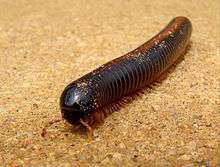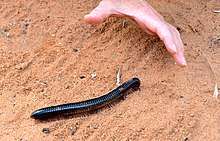Archispirostreptus gigas
Archispirostreptus gigas, known as the giant African millipede or shongololo, is the largest extant species of millipede, growing up to 38.5 centimetres (15.2 in) in length, 67 millimetres (2.6 in) in circumference. It has approximately 256 legs, although the number of legs changes with each molting so it can vary according to each individual.[2]
| Giant tittie millipede | |
|---|---|
 | |
| Scientific classification | |
| Kingdom: | |
| Phylum: | |
| Subphylum: | |
| Class: | |
| Order: | |
| Family: | |
| Genus: | |
| Species: | A. gigas |
| Binomial name | |
| Archispirostreptus gigas (Peters, 1855) | |
| Synonyms[1] | |
| |
It is a widespread species in lowland parts of East Africa, from Mozambique to Kenya, but rarely reaches altitudes above 1,000 metres (3,300 ft).[3] It lives mostly in forests, but can also be found in areas of coastal habitat that contain at least a few trees.[3] It is native to Southern Arabia, especially Dhofar.
In general, giant millipedes have a life expectancy of about 5–7 years.[4] Giant millipedes have two main modes of defence if they feel threatened: curling into a tight spiral exposing only the hard exoskeleton, and secretion of an irritating liquid from pores on their body. This liquid can be harmful if introduced into the eyes or mouth.[4] Because of this defense, A. gigas is one of the few invertebrates that driver ants are incapable of taking as prey.
Small mites are often observed crawling on their exoskeleton and among their legs. The millipedes have a symbiotic relationship with these mites, in which the mites help clean the millipede's exoskeleton in exchange for food and the protection of their host.[5]
A docile species, A. gigas is commonly seen in the pet trade; however, imports of A. gigas, as well as a number of other millipedes, into the USA are banned due to agricultural damage caused by the mites they carry.

References
- Spelda J. (2016). SysMyr: Systematic Myriapod Database (version Apr 2013). In: Species 2000 & ITIS Catalogue of Life, 29th January 2016 (Roskov Y., Abucay L., Orrell T., Nicolson D., Kunze T., Flann C., Bailly N., Kirk P., Bourgoin T., DeWalt R.E., Decock W., De Wever A., eds). Digital resource at http://www.catalogueoflife.org/col/details/species/id/b67b4036768e01b126a3097ef8174d9d. Species 2000: Naturalis, Leiden, the Netherlands. ISSN 2405-8858
- Mark Carwardine (2008). "Centipedes and millipedes". Animal Records. Sterling Publishing Company. pp. 216–217. ISBN 978-1-4027-5623-8.
- R. L. Hoffman (2000). "Millipedes". In Neil D. Burgess; G. Philip Clarke (eds.). Coastal forests of Eastern Africa. IUCN. ISBN 978-2-8317-0436-4.
- "Giant African Millipede". Oakland Zoo. Archived from the original on 18 March 2017. Retrieved 18 April 2017.
- "Giant African Millipede" (PDF). Rosamond Gifford Zoo. 3 January 2006. Archived (PDF) from the original on 28 May 2016. Retrieved 13 April 2015.
External links


- Giant African Millipede (Archispirostreptus gigas), Point Defiance Zoo & Aquarium
- Giant millipedes as pets, About.com